
This post may contain affiliate links or sponsored content. That means if you click on my link and buy something, I will earn a small commission from the advertiser at no additional cost to you. For more information on this, please click here.
Vegetable Caponata is a roasted version of the classic Sicilian sweet-and-sour condiment with a couple of twists–zucchini and bell peppers are added while the ever-present tomatoes are taken out. This tasty mixture with olives, capers, raisins and pine nuts actually gets better as it sits–reason enough to make an extra-large batch!

For more Sicilian-inspired dishes, check out Spaghetti with Breadcrumbs and Anchovies, Pasta with Cauliflower, Bucatini with Tuna Sauce, Calamari Stew with Potato and Peas and Eggplant Meatballs (without Meat).
What is Caponata?
Caponata is one of the signature dishes of the southernmost Italian region, Sicily. Pronounced ka-po-naa-tah, it is a type of eggplant-based antipasto salad that embraces the Sicilian culinary concept of agrodolce, or sweet and sour, which was brought to the Mediterranean island by the Arabs.
Like many dishes, you’ll find all sorts of variations of caponata across Sicily. My favorite is swordfish caponata that I enjoyed during my last trip there. It was a chunky and surprisingly light and flavorful interpretation of the classic.
But, most versions highlight the important Sicilian ingredient–eggplant. The eggplant is usually cut up into large chunks, deep-fried, then combined on the stovetop to cook in a sweet-and-sour vinegar/sugar base of, generally, onions, celery, tomatoes, briny capers, tangy olives and sweet raisins. A lovely combination!
It’s most often served as an appetizer, condiment or side dish.

What Inspired This Recipe
Years ago when I was in Rome for my friend Tuula’s wedding, I actually had lunch with the (French) groom, Nicolas, alone while the bride (my friend) was off doing pre-wedding stuff. I had met him for all of about five minutes prior to Tuula sending us off to lunch together. Fortunately, it turns out he was really into food (no surprise here, really, as he was French!), so we got along well and had lots to talk about. He took me to a Calabrese restaurant and ordered us his favorite dish there, caponata.
Of course, having a Sicilian-American mom and aunt, I had enjoyed and made what we called caponatina at home many times. But the version that I had at this restaurant really impressed and stuck with me as it had no tomatoes and a great texture and flavor!
This may not seem like a big deal, but tomatoes are always in caponata. That is just the way it is.
And, as much as I adore the red fruit in all its iterations, I think they might be the reason why I just never loved caponata. It was fine, and I would eat it. But I never loved its tomato-sauciness.
Until that day in the Calabrese restaurant in Rome with the French man.
This recipe is inspired by that caponata senza pomodori (without tomatoes) as well as my first ever vegetable garden, that just so happens to be abundant with, not only eggplant, but also zucchini and peppers.
And, in my forever quest to make cooking less messy, I have roasted the three core veggies in this vegetable caponata (eggplant, zucchini and bell peppers) instead of frying them. It might take a bit more time, but it saves a lot of clean-up and calories!
I hope you love the combination of savory, sweet, sour, briny, and tangy flavors in this Roasted Vegetable Caponata. If you have the time, make it at least one day in advance as it’s one of those dishes that improves over time! Mangia bene!

Ingredients for Roasted Vegetable Caponata
Here are the ingredients we will be using in this Sicilian sweet-and-sour relish:
- Eggplant, Zucchini and/or Yellow Squash and Bell Peppers: This caponata was inspired by summer’s bounty and so includes a mixture of vegetables, as opposed to only the traditional eggplant. Any variety of eggplant or zucchini can be used. Only use red, yellow or orange bell peppers and not green, which is much bitter and has a different flavor than the others.
- Onion and Celery: These aromatic vegetable are important flavor builders.
- Red Wine Vinegar and Sugar: These two important ingredients are the foundation for the signature agrodolce (sweet and sour) flavor of this dish. I use equal amount (by volume) of the vinegar and sugar, but you can adjust the proportion to your taste. Also, white wine vinegar can be used in place of the red, and other sweeteners, such as maple syrup, honey or coconut sugar, can replace the sugar. Please note that each ingredient substitution adds its own characteristic flavor to the finished dish.
- Green Olives and Capers: Both of these add a briny, salty punch to the dish. Choose large Sicilian or Greek olives, if possible.
- Raisins: These contribute both sweetness and texture to the caponata. Use either black or golden raisins, or a combination of both.
- Pine Nuts: This classic Sicilian ingredient adds crunch, flavor and a little bit of fat to the caponata. Fold them into the dish just before serving to maintain their texture.
- Fresh Herbs: These are an optional garnish and best folded in to the caponata just before serving. The best herbs for this mixture are flat-leaf parsley, mint and/or basil.
A complete and detailed list of ingredients with amounts and instructions is included in the recipe below.

Check out Confit Cherry Tomatoes and Garlic for another great late summer recipe.
How to Make Vegetable Caponata, Step-by-Step!
Here are the main steps for making this vegetable and eggplant caponata recipe:
- Preheat oven to 400°F and arrange a rack in the middle of the oven. Prep all ingredients. Toast pine nuts. Then, arrange the prepped bell peppers, zucchini/yellow squash and eggplant in a single layer on separate pans.
- PRO-TIP: Keep the different vegetables on separate sheet pans as they all cook at varying times. Also, do not salt the vegetables before they are roasted–salting will draw out liquid and make it harder for the vegetables to brown.

- Place the sheet pans in the oven and roast until the vegetables are tender and lightly browned. Turn the pans around about halfway through the cooking process.
- PRO-TIP: The vegetables should be tender but not overcooked and mushy. It’s ok if some of the pieces get fairy caramelized as they will look very beautiful in the final dish!

- Meanwhile, while the vegetables are roasting in the oven, add the onions, olive oil and crushed red pepper flakes to a large skillet over medium heat and cook for 5 minutes.
- Then, add the celery and cook for another 5 minutes, stirring occasionally. Then, turn off the heat.
- PRO-TIP: The vegetables should have a little bit of crunch at this point and not be overcooked and very soft.


- Once the eggplant, zucchini/squash and bell peppers are all finished cooking, return the onion/celery mixture to medium heat. Then, whisk the vinegar and sugar together and pour it into the onion mixture, along with the olives, capers, raisins, salt and black pepper and mix well. Bring to a simmer and let it simmer about 3-5 minutes.


- Then, gently stir in all of the roasted vegetables and mix to coat well, taking care not to break up the pieces of roasted veggies. Simmer about 5 to 8 minutes, gently stirring a few times.
- PRO-TIP: Coat the entire mixture in the vinegar/sugar solution. Taste and adjust the seasonings–add more vinegar or sugar as needed to balance the flavors.
- PRO-TIP: The trick to making a great caponata is to not overcook the vegetables. You do not want them crunchy, but cooking them until they are mushy is not ideal either. Tender but still with structure is ideal!


- Turn off the heat and let the mixture cool a bit. Use a slotted spoon or skimmer to transfer the caponata to a bowl or container.
- PRO-TIP: If there is any residual liquid, you can either store the mixture in the residual liquid or discard it. If left with the caponata, it will continue to “marinate”. So, if you prefer bolder flavors, keep it in and strain it out at the time of serving.


- Serve the caponata immediately or enjoy it later. It actually will get better as it sits! Feel free to make it up to 3 days in advance, them bring to room temperature and give it a light stir before serving. Fold in the pine nuts and herbs at the time of serving.
- PRO-TIP: Fresh herbs are optional, but add a nice brightness to the final dish. Gently mix them in before serving. The best herbs to use for this are flat leaf parsley, mint and/or basil.

More Eggplant Recipes
If you love eggplant as much as me, give these other recipe favorites a try!
- Roasted Eggplant with Crispy Garlic and Herbs
- Fried Eggplant Cutlets Milanese–breaded in homemade seasoned breadcrumbs and fried until crispy
- Sicilian Eggplant Meatballs–a meat-free, delicious alternative to a traditional meatball
- Pasta with Ricotta, Slow-Roasted Eggplant and Tomato–hearty and delicious!

Serving Suggestions and Storage
I have enjoyed this Roasted Vegetable Caponata so many ways! It is such a great condiment or side dish during the late summer (or frankly, anytime!) when local eggplant, zucchini and peppers are in abundance. Here are some of my favorite ways to enjoy caponata:
- As an important part of to an antipasto platter along with cured meats, cheeses, olives, etc.;
- Pair it with creamy ricotta or goat cheese and toasted bread for a quick and flavorful crostini;
- Served on or with simple grilled proteins, like chicken, steak or salmon. Caponata is great with BBQ, too!
- Add it to a sandwich! The rich flavors of vegetable caponata can really lift up a sandwich! Think of it like a slaw or pickle. It’s especially delicious on a classic Italian or meatball sub!
- Added to a platter of insalata caprese;
- With pasta! I like to have it with a simple olive-oil-and-Pecorino-dressed cheese ravioli, tortellini or capellini.
I’d love to hear how you like to enjoy this Roasted Vegetable Caponata. Please let me know in the comments below!
To store, refrigerate the vegetable caponata in an airtight container for up to 5 days or so, or freeze it up to 3 months for later use. Bring it to room temperature before serving.

Frequently Asked Questions
Here are answers to some frequently asked questions about Sicilian vegetable caponata:
Definitely! Traditionally, caponata is made exclusively with eggplant, so that will always work!
Unless you are using old eggplant that have been stored for too long, you do not need to salt any eggplant.
I realize this may be a controversial reply, since so many people swear by salting eggplants to remove its bitterness. The reality is that, over the years, farmers have bred out much of eggplants’ signature bitterness, rendering salting unnecessary. Having said this, click here for great information about salting eggplants.
Unless I’m making pickled eggplant, I never salt it.
Refrigerate the vegetable caponata in an airtight container for up to one week or so. You can freeze caponata for up to three months. Bring it to room temperature before serving.
These two dishes often get confused with each other! While southern French ratatouille and Sicilian caponata share many of the same vegetables, they are, indeed, very distinct dishes. Rataouille is more of a light vegetable stew served warm, while caponata is more of a relish or antipasto served at room temperature. Plus, caponata has that sweet and sour, briny kick to it from the vinegar, sugar, olives, capers and raisins!

If you’re looking for more delicious, vegetable dishes, check out Neapolitan Zucchini with Mint and Vinegar, Green Beans in Tomato Sauce, Sausage, Fennel and Mushrooms, Fried Italian Peppers, Italian Green Beans with Potatoes and Sautéed Broccoli Rabe.
Variations and Substitutions for Vegetable Caponata
Here are a few ways to change up this veggie and eggplant antipasto:
- Change the Proportions of Veggies: You can use this recipe for 100% eggplant, 50/50 eggplant/zucchini, etc. Traditionally, caponata is made exclusively with eggplant, so that will always work! You can also add mushrooms for a different depth of flavor.
- Vinegar and Sugar: You can use white wine vinegar in place of the red that is in the recipe, and other sweeteners, such as maple syrup, honey or coconut sugar, can replace the sugar. Please note that each ingredient substitution adds its own characteristic flavor to the finished dish.
- Make it spicy! For all the hot heads out there, I suggest either increasing the amount of crushed red pepper or adding some Calabrian chile paste at the beginning of the cooking process (or both) for increased heat. You can also drizzle the finished dish with some homemade chile oil!
- Add a Tomato Product: Tomatoes are another ingredient in the traditional version of caponata, which I left out so that the flavor of the vegetables could shine better. Having said this, if you’d like to add some tomato, I suggest adding about 1-1½ cups canned tomatoes to the onion celery mixture and letting it simmer for about 10 minutes. Alternatively, add about ¼ cup tomato paste to the sautéed onions and celery and let it caramelize for a couple of minutes.
Kitchen Tools for Roasted Vegetable Caponata
To make this eggplant antipasto recipe, you’ll need the following:
- Measuring cups and spoons
- Cutting board with non-slip mat underneath (I use shelf liner)
- Sharp chef’s knife
- Multiple bowls to hold prep
- Sheet pan
- Parchment paper
- Oven mitts
- Wooden or silicon spoons
- Large pan or Dutch oven
- Skimmer or slotted spoon

More Great Recipes to Try
I hope that you are enjoying Mangia With Michele and all of my Italian recipes!
If you’ve tried Roasted Vegetable Caponata or another recipe here, please let me know in the comments below. I love hearing from you!
FOLLOW ME on FACEBOOK and INSTAGRAM to see more delicious food and what might be going on behind the scenes!

Roasted Vegetable Caponata without Tomatoes
Ingredients
- 2 pounds eggplant, unpeeled, ¾” chunks
- 1½ pounds zucchini or yellow squash ¾” thick, quarter or half-moon pieces, depending on size
- 1½ pounds red, yellow or orange bell peppers (no green), ¾” chunks
- 1 pound yellow onion, large dice or thin slices cut in ½ (about 3 cups chopped)
- ½ cup extra virgin olive oil
- Pinch crushed red pepper (optional)
- 5 large celery stalks medium dice or thin slices (about 2 heaping cups chopped)
- ¾ cup red wine vinegar
- ¾ cup sugar
- ¾ cup pitted, large green olives, cut into ¼ lengthwise (Sicilian preferred)
- ½ cup capers, drained
- ½ cup raisins (black or golden or mixed)
- ½ tsp salt
- Pinch freshly ground black pepper
- ½ cup pine nuts
- ⅓ cup chopped mixed herbs (optional; see Note below.)
Instructions
- Preheat oven to 400°F and arrange a rack in the middle of the oven. Then, prep and gather all ingredients according to specifications above.
- Toast pine nuts: Add pine nuts to a small skillet and place it over medium-low heat. Heat pine nuts until lightly browned and fragrant, stirring occasionally, about 2 to 3 minutes. Do not walk away! Pine nuts (or any nut, for that matter) can turn from toasted to burned very quickly; so, close monitoring is a must. Once toasted, remove them from heat and let them cool. This step can be done up to 1 day in advance.½ cup pine nuts
- Spray three parchment-lined sheet pans lightly with oil. Then, arrange the prepped bell peppers, zucchini/yellow squash and eggplant in a single layer on separate pans since they all cook at varying times. Spray the tops of the vegetables lightly with olive oil. Do not add any salt.2 pounds eggplant,, 1½ pounds zucchini or yellow squash, 1½ pounds red, yellow or orange bell peppers (no green),
- Place the sheet pans in the oven and roast for 20 minutes. Turn all the pans around and roast until tender and lightly browned. This may take about another 20-30 minutes for the peppers about 30 minutes or so for the zucchini and eggplant, depending on your oven. The vegetables should be tender but not overcooked and mushy. It’s ok if some of the pieces get fairy caramelized as they will look very beautiful in the final dish!
- Meanwhile, while the vegetables are roasting in the oven, add the onions, olive oil and crushed red pepper (if including) to a large skillet over medium heat and cook for 5 minutes. Then, add the celery and cook for another 5 minutes, stirring occasionally. Then, turn off the heat. The vegetables should have a little bit of crunch at this point and not be overcooked and very soft.1 pound yellow onion,, ½ cup extra virgin olive oil, Pinch crushed red pepper, 5 large celery stalks
- Once the eggplant, zucchini/squash and bell peppers are all finished cooking, return the onion/celery mixture to medium heat.
- Whisk the vinegar and sugar together, then pour it into the onion mixture, along with the olives, capers, raisins, salt and black pepper and mix well. Bring to a simmer and let it simmer about 3-5 minutes.¾ cup red wine vinegar, ¾ cup sugar, ¾ cup pitted, large green olives,, ½ cup capers, drained, ½ cup raisins, ½ tsp salt, Pinch freshly ground black pepper
- Then, gently stir in all of the roasted vegetables and mix to coat well, taking care not to break up the pieces of roasted veggies.
- Bring mixture to a simmer and let it simmer for 5-8 minutes, gently stirring a few times. You want the entire mixture to be coated in the vinegar/sugar solution. Taste and adjust the seasonings–add more vinegar or sugar as needed to balance the flavors.
- Turn off the heat and let the mixture cool a bit. Use a slotted spoon or skimmer to transfer the caponata to a bowl or container and discard any residual liquid. Alternatively, you can keep the mixture in the residual liquid–see Note below.
- The caponata can be served immediately or enjoyed later. It actually will get better as it sits (although the color may darken over time)! Just bring it to room temperature and give it a light stir before serving. Fold in the pine nuts and herbs at the time of serving. Buon Appetito!⅓ cup chopped mixed herbs
Notes
- This recipe makes approximately 6 cups and will condense and shrink a bit more over time. You can cut this recipe in half for a smaller batch.
- Be sure to roast the eggplant, zucchini/summer squash and bell peppers on separate sheet pans, since they will all take different amounts of times to cook.
- Do not use green bell peppers in this dish. They have a completely different flavor than red/yellow/orange bell peppers and are not ideal for this recipe.
- The trick to making a great caponata is to not overcook the vegetables. You do not want them crunchy, but cooking them until they are mushy is not ideal either. Tender but still with structure is ideal!
- If there is residual liquid once the caponata has finished cooking, you can either discard it or store the caponata in it. If left with the caponata, it will continue to “marinate”. So, if you prefer bolder flavors, keep it in and strain it out at the time of serving.
- Fresh herbs are optional, but add a nice brightness to the final dish. Gently mix them in before serving. The best herbs to use for this are flat leaf parsley, mint and basil.
- To store, refrigerate the vegetable caponata in an airtight container for up to one week or so, or freeze it for later use. Bring it to room temperature before serving.

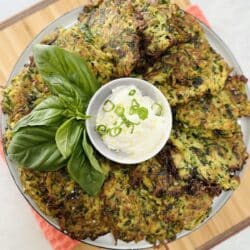
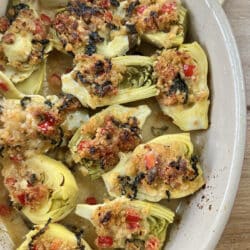
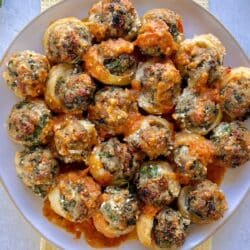
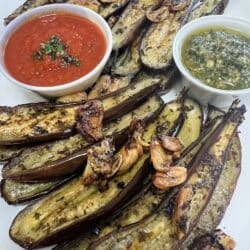
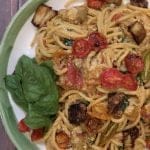
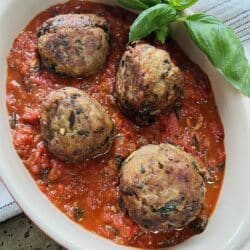

Caponata after freezing: I thawed it & served it with white bean hummus! Texture changed of course, but the (40) guests ate every bit! IMO, better fresh, but the guests know best!
Great! And I love your pairing with hummus, Kathy.
Delicious! Love it w/o tomatoes!! Veg stay firm, even leftover!
So happy you like the recipe, Kathy! And, I agree-the veg stay very firm!
Loved loved loved this recipe! I am unable to eat tomatoes but love eggplant. Thank you.
My pleasure. So happy that you like the recipe, Gloria! 🙂